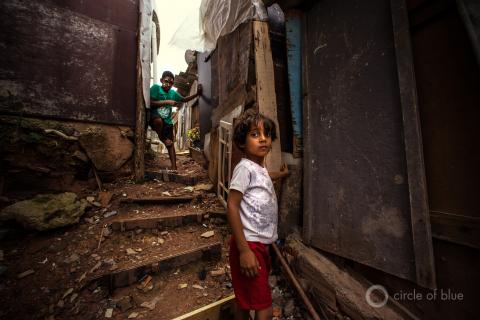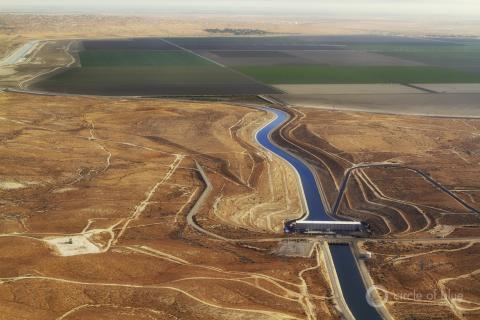A. Karim Ahmed, Secretary-Treasurer, GCSE Board of Directors; Adjunct Professor, University of Connecticut Health Center
J. Carl Ganter, Director, Circle of Blue; CEO, Vector Center
Sandra Postel, Director, Global Water Policy Project; Stockholm Water Prize Laureate 2021
Along with climate change and biodiversity loss, our planet faces a water crisis that is becoming increasingly grave each year. It should cause serious concern among policy makers and the public. Yet it seems to have not been given the degree of attention it deserves, even though the dire consequences of this potential calamity are just around the corner.

The World Health Organization has estimated that by 2025, half of the world’s population will be living in water-stressed regions (1). Unfortunately, climate change will only enhance and extend what is already a mounting problem in water resource management in many areas of the world. This will affect not only the human population, but will have enormous impacts on animal and plant species, causing widespread loss of biodiversity.
What are some of the current trends in global water scarcity? One of the UN’s Sustainable Development Goals is “universal and equitable access to safe and affordable drinking water.” Presently, this remains a formidable challenge. Safe drinking water is a basic life necessity, but is not readily available to 2.2 billion people, mostly those residing in low-income, developing regions of Asia, Africa and Latin America.
Probably the greatest global impediment in achieving the above sustainability goal is the uneven availability and distribution of water resources – between water-abundant and water-scarce regions, between urban and rural areas, between affluent and low-income neighborhoods.
A common village scene in a rural area of sub-Saharan Africa, would witness an eight-year old girl who accompanies her mother on many mornings before dawn to fetch water from a distant stream. Each day she is thoroughly worn out and tired before she starts school. Often she misses school because she has loose stool or diarrhea from drinking bacterially contaminated water from the frequently polluted stream.
In the foothills of the Himalayan Mountains in Nepal, we might see an eighteen-year-old boy tending sheep . Although he has ample access to clean water these days, his greatest worry is the unstable earthen dam that holds water in a glacial lake upriver from his home. He has been told to stay alert and vigilant, since rapid melting of mountain glaciers has filled these lakes to the brim, causing them to overflow, destroying many people’s lives and properties downstream.
While these two water-related scenarios may appear quite different, they have one thing in common – lack of access to adequate water resources, whether at the present time or in the near future. For inhabitants in the African village, a meager amount of unsafe water is now available through physically demanding toil, walking an average of three to four miles each day to the nearest source. In the Himalayan region, there is great uncertainty about their future source of water once the mountain glaciers have significantly receded from the continuing effects of climate change and global warming.
It is believed by many observers that such rapid decrease of glacial snow and ice in the Himalayan-Karakorum ranges and the Tibetan highlands could lead to drastic decline of water flow in major rivers and tributaries in highly populated areas (> 2 billion people) of South and Southeast Asia by mid-century. This has enormous implications for mass migration of inhabitants living in these regions in the not-too-distant future.
Explore additional water challenges around the world through the lens of photojournalism in this image gallery by photographer and journalist J. Carl Ganter.
What about problems of water stress in the richer countries of Europe and North America? Here the main issue resides in the uneven availability of water resources. About one-third of Europe, especially in its Southern and heavily populated Northern regions, suffers from low availability of water (< 5000 cubic meters per head per year). Moreover, shifts in the Gulf Stream’s oceanic movement in the North Atlantic from the effects of climate change might drastically reduce precipitation over much of Western Europe in the coming decades.

Similarly, in parts of the United States, serious loss of water resources is anticipated for the remainder of the 21st century, especially in certain water-stressed regions of the country. This sobering conclusion was reached in a recent report issued by the American Geophysical Union. The geographical regions most affected are California, the Southwest, the central Rocky Mountains, and parts of Florida and the Midwest.
One of the greatest impacts in the US would be felt by the depletion of the country’s main water source for irrigation, the Ogallala Aquifer, which spans some 174,000 square miles over parts of eight states that lie West of the Mississippi River. Without doubt, the sharp decline of this valuable groundwater resource would cause a major dislocation in the agricultural economies of several High Plains states.
Among practical means that must be taken to address this looming global crisis, conservation measures and efficient use of water, along with extensive consumer education programs, are critically needed. An equally important element is the requirement to build resilience and undertake adaptation projects to confront the inevitability of water scarcity, and of more intense floods and droughts, in many regions.
The conceptual framework and practice of “ecosystem-based adaptation” in water resources management should be widely adopted. That is working with nature rather than further disrupting the natural water cycle should be the primary policy objective of all those involved in sustainable development projects. Above all, we should shed our current human-centered priorities and take into account the basic requirements of all animal and plant species for their water needs. It is therefore just and appropriate for us to declare a “biotic right” to water for every living species to nurture and thrive on this planet.
Such a resilience/adaptation approach includes restitution of the land-ocean water cycle, preservation of coastal and marine life (e.g., mangroves, coral reefs), protection of freshwater wetlands, restoring riverine floodplains, and recharging of aquifer basins, while at the same time assessing risks, building infrastructure and enacting restrictive regulations to combat sea-level rise, storm surges, inland flooding and other extreme weather events.
In the developing country context, the principle of the “human right to water” for vulnerable and marginalized populations has been invoked by the United Nations and other international organizations. In brief, this conceptual framework states that “the human right to water entitles everyone to sufficient, safe, acceptable, physically accessible and affordable water for personal and domestic uses.” (UNCESCR, General Comment No. 15, 2002).
It is abundantly clear the world faces a growing problem of water-related stress, loss of ecosystem function, mounting natural disasters, and inadequate supply of clean, safe water for a large fraction of its population, with which we are currently unprepared to cope in any well-integrated and sustainable manner. On this World Water Day, it would be wise for us to pay attention to what lies ahead and take crucially important steps to bring about a more viable future for humans and all living beings on our troubled planet.
The opinions expressed in this essay are those of the authors. They do not purport to reflect the opinions or views of the GCSE or its members.